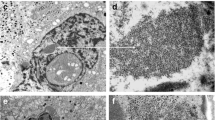Abstract
The immunoreactivity of a monoclonal antibody against cell suspensions from guinea pig adrenal glands was examined at light- and electron-microscopic levels. In addition to the cell surface membrane of adrenocortical cells, the antibody labeled specific sites in the pancreas, liver and testis, but did not label any of the other tissues examined. In the pancreas, microvilli-like processes and the cell surface membrane of centroacinar cells were immunoreactive to the antibody. The microvilli of interlobular duct cells and pancreatic duct cells were also immunoreactive. In the liver, bile canalicular microvilli of hepatocytes were exclusively labeled. Membrane structures of cell organelles, mainly mitochondria, in testicular Leydig cells were also labeled. Immunoblot analysis showed that the monoclonal antibody bound to two common bands at molecular weights of approximately 62 kDa and 110 kDa in the pancreas, liver, testis, and adrenal gland. The two bands reacted with the digoxigenin-conjugated lectin, Sambucus nigra agglutinin (SNA), which recognizes sialic acid linked α(2–6) to galactose. Reaction patterns of SNA in the pancreas, liver and testis were similar to those of the monoclonal antibody; pancreatic centroacinar cells and interlobular duct cells, hepatocyte bile canaliculi and testicular Leydig cells were densely stained with SNA. Thus, the monoclonal antibody recognizes two common membrane glycoproteins containing sialic acids in the pancreas, liver, testis and adrenal cortex.
Similar content being viewed by others
References
Bartles JR, Braiterman LT, Hubbard AL (1985) Biochemical characterization of domain-specific glycoproteins of the rat hepatocyte plasma membrane. J Biol Chem 260:12792–12802
Castle JD, Cameron RS, Patterson PL, Ma AK (1985) Identification of high molecular weight antigens structurally related to gamma-glutamyl transferase in epithelial tissues. J Membrane Biol 87:13–26
Christensen AK (1965) The fine structure of testicular interstitial cells in guinea pigs. J Cell Biol 26:911–935
Cook J, Hou E, Hou Y, Cairo A, Doyle D (1983) Establishment of plasma membrane domains in hepatocytes. I. Characterization and localization to the bile canaliculus of three antigens externally oriented in the plasma membrane. J Cell Biol 97:1823–1833
Guldenaar SEF, Pickering BT (1985) Immunocytochemical evidence for the presence of oxytocin in rat testis. Cell Tissue Res 240:485–487
Guraya SS (1980) Recent progress in the morphology, histochemistry, biochemistry, and physiology of developing and maturing mammalian testis. Int Rev Cytol 62:187–309
Hixson DC, Allison JP, Chesner JE, Leger MJ, Ridge LL, Walborg EF Jr (1983) Characterization of a family of glycoproteins associated with the bile canalicular membrane of normal hepatocytes but not expressed by two transplantable rat hepatocellular carcinomas. Cancer Res 43:3874–3884
Hubbard AL, Bartles JR, Braiterman LT (1985) Identification of rat hepatocyte plasma membrane proteins using monoclonal antibodies. J Cell Biol 100:1115–1125
Itai S, Arii S, Tobe R, Kitahara A, Kim Y, Yamabe H, Ohtsuki H, Kirihara Y, Shigeta K, Kannagi R (1988) Significance of 2–3 and 2–6 sialylation of Lewis A antigen in pancreas cancer. Cancer 61:775–787
Ito N, Nishi K, Nakajima M, Okamura Y, Hirota T (1990) Histochemical localization and analysis of blood group-related antigens in human pancreas using immunostaining with monoclonal antibodies and exoglycosidase digestion. J Histochem Cytochem 38:1331–1340
Kameda Y (1992) Production of monoclonal antibodies against a novel glycoprotein synthesized and secreted by dog thyroid C-cells. J Histochem Cytochem 40:541–553
Kameda Y, Hirota C (1993) Production of a monoclonal antibody against cell-surface glycoprotein of guinea pig adrenocortical cells. J Histochem Cytochem 41:235–243
Kurosumi M, Ishimura K, Yoshinaga T, Fujita H, Tamaoki B (1986) Immunocytochemical localization of 17β-hydroxysteroid dehydrogenase in porcine testis. Histochemistry 85:287–289
Matsuura S, Eto S, Kato K, Tashiro Y (1984) Ferritin immunoelectron microscopic localization of 5′-nucleotidase on rat liver cell surface. J Cell Biol 99:166–173
Miller SC, Bowman BM, Rowland HG (1983) Structure, cytochemistry, endocytic activity, and immunoglobulin (Fc) receptors of rat testicular interstitial-tissue macrophages. Am J Anat 168:1–13
Ocklind C, Forsum U, Öbrink B (1983) Cell surface localization and tissue distribution of a hepatocyte cell-cell adhesion glycoprotein (Cell-CAM 105). J Cell Biol 96:1168–1171
Ogawa H, Mink J, Hardison WGM, Miyai K (1990) Alkaline phosphatase activity in hepatic tissue and serum correlates with amount and type of bile acid load. Lab Invest 62:87–95
Parmentier M, Inagami T, Pochet R, Desclin JC (1983) Pituitarydependent renin-like immunoreactivity in rat testis. Endocrinology 112:1318–1323
Roman LM, Hubbard AL (1983) A domain-specific marker for the hepatocyte plasma membrane: localization of leucine aminopeptidase to the bile canalicular domain. J Cell Biol 96:1548–1558
Sata T, Zuber C, Roth J (1990) Lectin-digoxigenin conjugates: a new hapten system for glycoconjugate cytochemistry. Histochemistry 94:1–11
Stamatoglou SC, Rui-Chang G, Mills G, Butters TD, Zaidi F, Hughes RC (1990) Identification of a novel glycoprotein (AGp 110) involved in interactions of rat liver parenchymal cells with fibronectin. J Cell Biol 111:2117–2127
Straaten HWM van, Wensing CJG (1978) Leydig cell development in the testis of the pig. Biol Reprod 18:86–93
Tsong SD, Phillips D, Nalmi N, Liotta AS, Margioris A, Bardin CW, Krieger DT (1982) ACTH and β-endorphin-related peptides are present in multiple sites in the reproductive tract of the male rat. Endocrinology 110:2204–2206
Wahlström T, Huhtaniemi I, Novatta O, Seppälä M (1983) Localization of luteinizing hormone, follicle-stimulating hormone, prolactin, and their receptors in human and rat testis using immunohistochemistry and radioreceptor assay. J Clin Endocrinol Metab 57:825–830
Yasuda K, Shiozawa M, Aiso S, Taniguchi S, Yamashita S (1990) Distribution of gamma-glutamyl transpeptidase in human pancreas: immunohistochemical study with a monoclonal antibody. J Histochem Cytochem 38:339–350
Author information
Authors and Affiliations
Rights and permissions
About this article
Cite this article
Kameda, Y., Hirota, C. & Miyauchi, R. Staining of pancreatic centroacinar cells, liver bile canaliculi and testicular Leydig cells with a monoclonal antibody against adrenocortical cells. Cell Tissue Res 272, 407–416 (1993). https://doi.org/10.1007/BF00318547
Received:
Accepted:
Issue Date:
DOI: https://doi.org/10.1007/BF00318547




